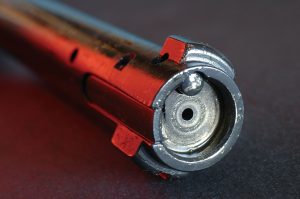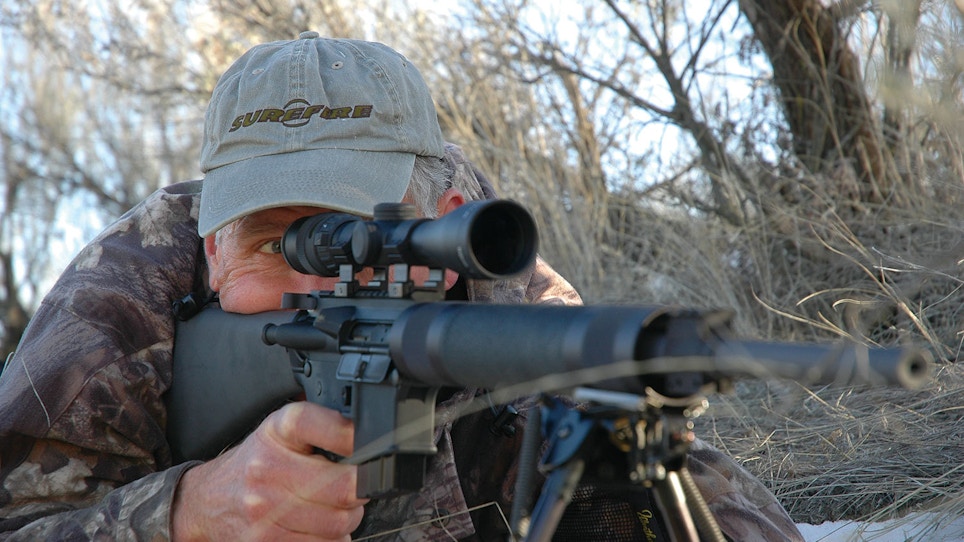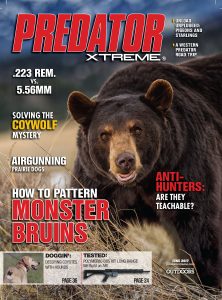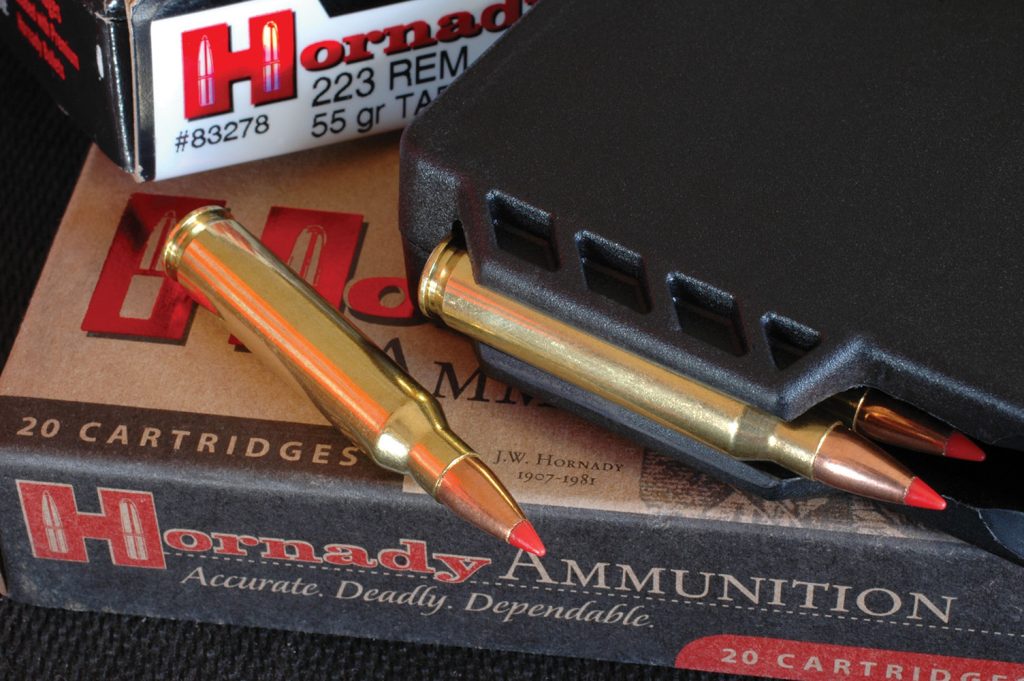The .223 appeared in 1957 as an experimental round for Armalite’s AR-15 combat rifle. Adopted in 1964 as the 5.56mm Ball cartridge M193, it owed much of its success to Bob Hutton, technical editor of Guns & Ammo. With Gene Stoner of Armalite, Hutton paired a 55-grain bullet with a case a tad longer than the .222 to meet the spec for retained velocity: supersonic at 500 yards. With an exit speed of 3,250 fps, the M193 load was issued to U.S. forces in Vietnam, and following the war until 1984. In 1980 it got the blessing of NATO countries, which substituted the FN-designed 62-grain SS109 boattail bullet, with a mild-steel penetrating component. The SS109 left the muzzle at 3,100 fps and hit harder at long ranges than the 55-grain boattail. Faster barrel twist (a change to 1:7) gave it superior accuracy as well. The U.S. Army called this load the M855. By this time, the cartridge had become known in military circles as the 5.56 NATO or 5.56x45 (the 45 being case length in millimeters, per European custom).
Remington was the first to chamber this round in sporting rifles. That decision, and certainly the .223’s design, owed much to the popularity of the .222 Rem., which dominated Benchrest matches and delighted fox hunters following its 1950 debut. The .223’s case length of 1.76 inches exceeds by very little that of the 1.7-inch .222 Rem.
But the .223 has a short neck, and its powder capacity exceeds the .222’s by 20 percent. When the 1.85-inch hull, considered by Remington and Springfield Armory as a prospect for infantry rifles, proved too long for the Armalite action, Remington introduced it as a sporting round. The .222 Rem. Mag. was introduced in 1958, appearing in the company’s 722 bolt rifle.
When Remington began barreling for the .223 and loading ammunition, it could have replicated chamber dimensions and breech pressures. Instead, it specified a shorter throat (freebore in front of the chamber) and steeper leade (angle of the lands, groove to bore diameter, in front of the throat). In battle, the 5.56 NATO didn’t have to yield the accuracy varmint hunters expected of the .223. Most important to soldiers was reliability in harsh environments and with dirty ammo and long-nosed tracer bullets. Generous chambers also kept stiff military loads from hiking pressures above red-line on hot days or when volleys of fire brought barrels to egg-cooking temperatures. A hunter trying to decapitate a small rodent far away wanted instead a snug chamber, short bullet jump to full control by the rifling. He or she also preferred fast, frangible hollowpoint bullets, not SS109 hardball. So rifling in Remington sporters was initially cut with the 1:12 twist appropriate for relatively short bullets.
Many shooters have since come to view the .223 and 5.56 as identical cartridges — interchangeable in rifles bored for either. Listed case dimensions are identical; each will chamber in barrels marked for the other. But differences remain in ammunition and rifles. According to ballisticians at Hornady, the .223 is loaded to a SAAMI (Sporting Arms and Ammunition Manufacturers Institute) pressure of 55,400 CUP (Copper Units of Pressure). Service loads for the 5.56x45 NATO generate 58,500. And while rifling twist and chamber dimensions now vary a great deal when talking about AR-style rifles as well as bolt guns, you can expect bores cut for the 5.56 to have .125 more freebore than those in .223.
In 1979, SAAMI cautioned shooters that chambers for 5.56x45 military loads differed from those in .223 sporting rifles. The warnings continued, saying that high pressures could result from use of 5.56 ammo in .223 barrels. A pal with a background in military munitions warns of “sticky cases and blown primers” in .223 rifles fed 5.56 ammo.
He’s also observed sub-par velocities from 5.56 rifles firing commercial .223 loads. On the other hand, some manufacturers claim both cartridges can be fired safely in their .223 rifles. In ballistics tables and handloading manuals, you’ll find some .223 loads as hot as common 5.56 loads.
The proliferation of AR-15 rifles in other than battle form has contributed mightily to the ocean of .223 commercial loads now available. Hornady alone lists 14 — from a 35-grain NTX bullet at a sizzling 3,760 fps to a 75-grain Superformance Match BTHP at 2,930. Black Hills works tirelessly to refine .223 ammo. Its 5.56 production serves U.S. troops. Besides wringing top accuracy from this case, Black Hills shreds tons of ballistic gelatin in terminal performance trials. My tests of AR-style and bolt-action .223s always include Black Hills ammunition, plus loads from Federal and Hornady.
Which bullet should you pick for predators? Mid-weight boat-tail hollowpoints are hard to beat. Frangible fly-weights (40 grains and lighter) may spare you the patching of exit holes on pelts — or not. But 50- and 55-grain bullets scribe flatter arcs at distance and retain energy better. They also track well from a range of twist rates — say, 1:12 to 1:8. Short, lightly constructed bullets clocking over 3,500 fps can disintegrate as they emerge from fast-twist bores, leaving a wink of blue or invisible shards on a path to nowhere.
Were I to order a .223 barrel tomorrow, it would have 1:9 twist. Consensus seems to be that this rate of spin will stabilize most BTHP bullets to 75 grains. They’ll shoot 50-grain bullets as accurately as most barrels rifled 1-in-12. In my tests, 1:12 bores kept groups tight with bullets as heavy as 62 grains but failed to adequately stabilize some 69-grain hollowpoints. I have more use for heavy bullets in a .223 than for the lightest. And generally you’re better served by twist a tad too fast than spin slightly slow.
When the Vietnam War was raging, the M-16 rifle and 5.56x45 NATO cartridge were given low marks by veterans who’d become fast friends with Garands in .30-06. Aside from early reliability issues with the M-16 mechanism, there was the question of lethality.
The Hague Accords of 1899 (not the Geneva Convention, as is commonly referenced) prohibited the use, in war, of bullets “designed to increase the severity of wounds, or suffering by the wounded.” So signatories couldn’t field soft-nose bullets. Of course, not all hostile forces were, or are, signatories. Then in 1990, a legal ruling exempted sniper-favored hollowpoint match bullets because their design was not to cause more grievous wounds, but to flatten bullet arcs and improve accuracy!
FMJ infantry ammo in Vietnam proved surprisingly effective because the 5.56 bullets tumbled on entry. Terminal tumbling wasn’t unknown, but bullets from the .30-06 and .308 (7.62x51 NATO, in the M14) hadn’t shown this tendency. Why?
Rifling stabilizes a bullet by spinning it like a top. When a top loses rotational speed, it wobbles then falls. Spin rate, determined by the rifling, keeps a bullet point-forward through air. But when it enters a new, denser medium, that rotation is no longer adequate to maintain point-forward flight. If the bullet’s center of mass differs from its center of form — true for all bullets with tapered noses — the yaw produced by instability is compounded by that disparity. Increasing friction lends a hand as the bullet tilts relative to flight-line. Eventually the overturning moment causes the bullet to swap ends. Its path through the new medium is then unpredictable but typically destructive.
The slower .30-bore bullets U.S. troops used in World War II also tumble, but must drive deeper in soft tissue to lose their point-on stability. The track and final disposition of any bullet depend on its shape and length and weight, not just its velocity and diameter. (The medium matters, too.) The closer center of mass to center of form, the less apt a bullet is to tumble. Think: near-cylindrical profiles, flat or blunt up front.

The Howa Mini bolt is properly slim for the 0.378-inch case head of the .223. The .308 has a 0.473-inch head.
Now, these bullets have shot-put arcs that limit reach. Also, you’ll want more predictable terminal action than an FMJ’s. The vitals of small animals present too little resistance to ensure tumbling from most .223 missiles. Softpoints and hollowpoints with thin jackets rupture quickly for humane kills.
For larger game, .22 centerfires won’t kill deer reliably. But defining legal rounds by bullet diameter begs review. The common minimum of .243, for example, black-balls the .22-50 and the .220 Swift, as well as the .223, but embraces the .44-40, even the .25-20!
Carbines in .44-40 have killed truck-loads of deer. The .44-40’s 200-grain bullet in a Winchester factory load registers 630 ft./lbs. of energy at exit — and 450 at 100 yards.
That’s a great deal more than the .25-20 (410 and 275, respectfully). But it falls well shy of the energy generated by Winchester 55-grain .223 Ballistic Silvertip — 1,280 and 1,005 ft./lbs., respectfully. You could argue it wasn’t designed for big game, and that the killing power of 200-grain .44-40 is underrated. But Winchester’s 64-grain Power Point at 3,020 fps matches the muscle of varmint-style 55-grain HPs. Ditto Federal’s 64-grain softpoint at 3,050 fps, Remington’s 62-grain Core-Lokt Ultra Bonded at 3,100.
The 55-grain Hornady GMX driven 3,250 fps from factory loads is equally deadly on deer. Naturally .22 bullets require precise placement for quick lethal effect on deer and game of similar size.
While demans for .223 ammo was popularized through AR-style rifles, I’m sweet on bolt-actions.
The most accurate I’ve used was a Surgeon. It had a short, stiff barrel, a trigger that read my mind. My first group spanned 3⁄8 inch. I telephoned Preston Pritchett, who assembled this nail-driver, to compliment him on this sight. There was a brief silence then he replied, “Try another load. It should do
better than that!”
A Note for Handloaders
Data abounds for .223 handloads. You’re smart to use tested charges, especially for AR-15 rifles. Besides tight groups and the highest practical velocities, recommended powders give you port pressures that ensure hitch-free function without beating up your AR. The .223 is versatile inside a narrow pressure range. There’s no need to download or to hot-rod this cartridge. If you must experiment, try other bullets. The selection is mind-numbing! I’ve had fine results from Sierra 69-grain and 77-grain MatchKings.








